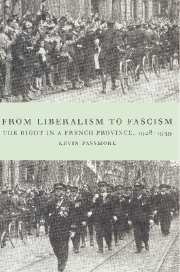Book contents
- Frontmatter
- Contents
- List of illustrations
- Preface
- List of abbreviations
- 1 Introduction
- 2 From France to the Rhône
- 3 Urban society in the Rhône
- 4 Rural society in the Rhône
- 5 The crisis of the right I: 1928–1932
- 6 The impact of the economic crisis
- 7 The crisis of the right II: 1932–June 1936
- 8 The Croix de Feu
- 9 The right and the Popular Front
- 10 Conclusion
- Appendix 1 Equations for multiple regressions
- Appendix 2 The conservative deputies of the Rhône, 1928–1940
- Select bibliography
- Index
Preface
Published online by Cambridge University Press: 23 December 2009
- Frontmatter
- Contents
- List of illustrations
- Preface
- List of abbreviations
- 1 Introduction
- 2 From France to the Rhône
- 3 Urban society in the Rhône
- 4 Rural society in the Rhône
- 5 The crisis of the right I: 1928–1932
- 6 The impact of the economic crisis
- 7 The crisis of the right II: 1932–June 1936
- 8 The Croix de Feu
- 9 The right and the Popular Front
- 10 Conclusion
- Appendix 1 Equations for multiple regressions
- Appendix 2 The conservative deputies of the Rhône, 1928–1940
- Select bibliography
- Index
Summary
The view that fascism is a phenomenon with roots in France, if not yet widely accepted, has in recent years become a respectable subject for debate amongst historians. Most would admit that there is a grain of truth in Zeev Stemhell's contention that figures such as Déroulède and Barrès contributed to the emergence of fascism, and perhaps even invented it. Robert Paxton's view that the Vichy regime, although not fascist, leaned in that direction, and needed no prompting from the occupying power to engage in antidemocratic and antisemitic measures, has become the orthodox framework for interpretation of that regime. Yet the question of whether France in the 1930s possessed an indigenous mass fascist movement has received comparatively little attention. This is surprising, given that the Croix de Feu and its successor, the Parti social frangais, possessed perhaps three-quarters of a million members at the movement's peak in 1937, and were seen as fascist by the left and even by many right-wingers. Until the late 1980s historians were content to accept René Rémond's contention that the Croix de Feu/PSF were ‘Bonapartist’, a peculiarly French form of authoritarianism that had nothing to do with fascism. At last, however, with the publication in 1995 of Robert Soucy's French Fascism: The Second Wave, a study of the Croix de Feu based on extensive archival research has appeared It calls into question many of the received ideas on which discussions of the Croix de Feu/PSF have rested. For Soucy there is no doubt that the movement represented a French fascism.
- Type
- Chapter
- Information
- From Liberalism to FascismThe Right in a French Province, 1928–1939, pp. xi - xvPublisher: Cambridge University PressPrint publication year: 1997

